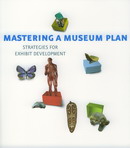review by Georgia Rouette

I must admit that I become rather excited when a new publication on exhibition development comes on the market. As exhibition developers, we continually strive to find the best strategies and methodologies to produce exhibitions that have relevancy, as well as currency, to a broad audience. Having a history in curatorial and registration positions, including exhibition development and production in both small and large organisations, I have found that the issues concerning exhibition development are all one and the same. The challenge is always how to realise an idea from concept to delivery within time, budgetary and resource constraints; how to best tell the story that is meaningful and enriching to a broad audience. This is equally challenging for large multidisciplinary museums as well as very small resource-poor museums.
When a publication surfaces that explains and offers strategies to address some of these complex issues in a visual way, then one must stop and pay heed. In Mastering a Museum Plan: Strategies for Exhibit Development, Dirk Houtgraaf and Vanda Vitali have meticulously provided the museum community a visually rich explanation on the imperatives for planning museum exhibits.
Mastering a Museum Plan is a publication written and produced by Naturalis, The National Museum of Natural History, The Netherlands. Lavishly published with glossy full colour illustrations, flow charts, and photographs, it is an accessible read. Using the museum's redevelopment as the discussion point the authors articulate the necessity for all museums to develop each project according to the overall intended message of the exhibit. Houtgraaf and Vitali argue that the project management process, including design and parallel activities, should reflect this intended message.
The four stages of exhibition development are universal and understood by most museums: concept, storyline, design and production. There are many publications outlining this process. What separates this publication from the rest is the use of many flow charts, figures, photographs and content maps that break down the phases and sub-phases in a clear and accessible way, all along maintaining that the intended message drives process. The authors introduce some of the key activities and methodologies succinctly. Although 'text-light', the use of the various visuals highlights the complexities of exhibition development. At first glance this can seem daunting. Sometimes it is! The appendix further breaks down the process in phases, description and deliverables, again highlighting the intricacies of exhibition development. The good news is that we all go through most if not all of these steps. The authors have quite vigilantly documented the phases.
Houtgraaf and Vitali mention when describing the scope and audience of the publication that it will be of interest to a wide museum audience including students and anyone involved in developing exhibitions. The publication assumes that readers are well-versed in the process. Many of the ideas and project management terminology in the publication may be new to students and those working in small, volunteer-run museums. A glossary of key terms and perhaps a short bibliography to assist those new to exhibition development would have been a useful addition to the book.
Although I suspect that the small museum will look upon this process as ambitious and to some extent unreachable, I believe that all museums should at least be aware of how the exhibit development planning process can work. The use of flow charts and the listing of detailed description in the appendix can also serve as a benchmark and a wish list for small museums, particularly when lobbying for more funds and resources from government, philanthropic and corporate sponsors. So many exhibitions fail for so many reasons. For me this publication has affirmed that if an organisation is unable to successfully secure the resources required to achieve the intended message through a quality exhibition, then it should seek alternative ways to reach its audience, such as a publication, a public program or an online exhibition.
Exhibitions do not just happen. The process is complex, costly, time consuming, and requires many skills both internal and external to make it work. Most successful exhibitions undertake years of thought and preparation. Mastering a Museum Plan: Strategies for Exhibit Development has highlighted this multifaceted process. The necessity for all museums to be focused, and avoid deviating from the intended message is something not to be taken lightly. I recommend that all exhibition developers have this publication by their side. I know I will.
Georgia Rouette is manager, exhibitions and touring services at Museums Australia Victoria.
